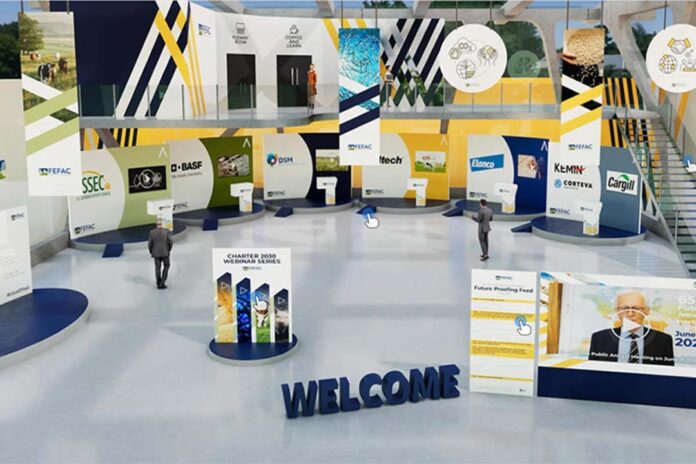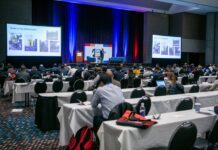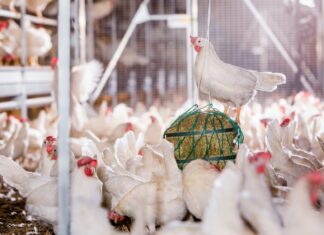
The online conference included sessions that zoomed in on innovation in animal nutrition and new pathways to increased EU protein production.
At the digitally live-streamed 3-D platform used for the FEFAC 65th Congress: Future Proofing Feed, the keynotes speeches were delivered by the EU Agriculture Commissioner Janusz Wojciechowski, EU Farm Council President Maria do Céu Antunes, COPA President Christiane Lambert, DG AGRI Deputy Head of Unit Research & Innovation Tereza Budňáková and Frank O’Mara, President of the Animal Task Force.
EU Farm Commissioner Janusz Wojciechowski stated: “The EU Commission has engaged in the Farm to Fork Strategy to examine EU rules to reduce the EU dependency on plant proteins (in particular for oilseeds and meals) by fostering EU-grown plant proteins as well as alternative feed materials”. He noted “the five ambitions of the Charter on Feed Sustainability and the Horizon Europe programme are closely linked with specific Green Deal objectives. They are evidence that the feed sector holds a key role in enhancing the sustainability of animal and arable production”.
EU Farm Council President Maria do Céu Antunes highlighted the “willingness to feed manufacturers to contribute to a fair, digital transition of our economy” echoing the EU objective “to bet on reinforcement of our strategic EU autonomy (on feed proteins)”.
Innovation in animal nutrition
The first panel discussion, featuring Eva Zamora (European Commission), Séverine Deschandelliers (FEFANA president), Dirk Ehle (Board Member of Animal Health Europe) and Reinder Sijtsma (Chair of FEFAC’s Premix and Mineral Feed Committee) was dedicated to Innovation in animal nutrition to tackle climate change and environmental impacts of the EU livestock and aquaculture sector. All speakers acknowledged the huge potential of animal nutrition to help farmers in the transition to more sustainable practices, including the reduction of environmental emissions but also animal health and welfare to reduce the needs for antimicrobials. They insisted on the importance of stimulating innovation through private/public and multidisciplinary partnership benefitting also from knowledge transfer from other sectors like human health.
Speakers also agreed that an efficient legal framework in particular for feed additives (less administrative burden, better market protection for applicants, new recognised functions for welfare and environment protection), together with possibilities to communicate to farmers on scientifically proven effects were preconditions to make these innovative feeding strategies available to farmers. However, acquisition of these solutions also requires investments at farm level, which farmers should be rewarded for and the benefits in terms of e.g. reduction of livestock emissions at individual farm level should be captured by models used by Member States for their emissions inventories.
Improvement in accuracy of models will also require public investments in research. Public communication efforts and stakeholders engagement were an essential element of the puzzle to tackle concerns of EU citizens with regards to certain innovations, in order to foster EU ambitions to become a model of successful transition to more sustainable food systems.
New pathways for EU protein production
The second panel discussion, featuring Michael Scannell (Deputy Director-General, DG AGRI European Commission), Pekka Pesonen (Secretary-General, Copa-Cogeca), Régis Fournier (President Euroseeds) and Asbjørn Børsting (FEFAC President) was dedicated to acknowledgement that the new CAP reform provides several elements like voluntary coupled support, eco-schemes, rural development investment programs that can help boost protein production in the EU and reduce the EU dependency on rich protein feed materials.
All speakers agreed that innovation is a “must have” tool to ensure the success of the Green Deal and its Farm to Fork Strategy. New tools should be provided by suppliers and more importantly allowed to be used by farmers to produce more with less to mitigate climate change impacts. This is the case especially when it comes to New Genomic Techniques.
Panelists agreed that this modern plant breeding technology may significantly contribute to increasing the EU protein self-sufficiency as well as to help reduce the footprint of feed production. It is, therefore, necessary that the EU legislators will swiftly introduce a favourable framework that allows industry and farmers to use them, following public consultations and impact assessments. The EU must not isolate itself from the international trade environment that is generally favourable to NGTs.
Michael Scannell, DG AGRI, stated: “feed manufacturers are well-advised to promote sustainable sourcing practices and traceability of feed materials to respond to retailers questions where they are sourced from”. He pointed to two new EU planned initiatives, the upcoming voluntary Code of Conduct for Responsible Business & Marketing Practices in the food chain and mandatory due diligence measures, with a key focus on deforestation-free supply chains.
FEFAC President, Asbjørn Børsting replied by referring to “FEFAC’s Soy Sourcing Guidelines 2021, including the possibility for verification and certification programmes to be benchmarked on ‘conversion-free soy’, as a proactive initiative to facilitate the transition to a more sustainable supply chain, with clear progress on the ground (78% of soy used coming from low-risk deforestation areas and 49% of soy usage in the feed industry according to FEFAC’s SSG criteria in 2019)”.
The day ahead of the online conference, FEFAC published the Feed Sustainability Charter Progress Report 2021. This publication contains an overview of FEFAC activities and deliverables from the past year in relation to the five Charter ambitions on how the European Feed Industry can contribute to the development of more sustainable livestock and aquaculture value chains.

















